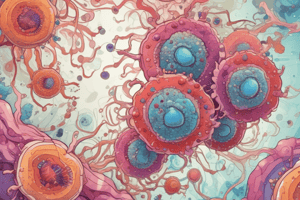Podcast
Questions and Answers
Bacteria positive for both MR and VP tests are common.
Bacteria positive for both MR and VP tests are common.
False (B)
Citrate Utilization Test is used to identify organisms that can use citrate as the sole nitrogen source.
Citrate Utilization Test is used to identify organisms that can use citrate as the sole nitrogen source.
False (B)
Bacteria that can grow in Simmons Citrate Agar medium produce the enzyme citrate-permease.
Bacteria that can grow in Simmons Citrate Agar medium produce the enzyme citrate-permease.
True (A)
In the Citrate Utilization Test, a color change from green to blue indicates a negative reaction.
In the Citrate Utilization Test, a color change from green to blue indicates a negative reaction.
Christensen's citrate medium uses bromothymol blue as the pH indicator.
Christensen's citrate medium uses bromothymol blue as the pH indicator.
Bromothymol blue indicator turns from yellow to pink in an acidic pH.
Bromothymol blue indicator turns from yellow to pink in an acidic pH.
In Kligler iron agar (KIA), the medium is identical to TSI except for the presence of glucose as a carbohydrate component.
In Kligler iron agar (KIA), the medium is identical to TSI except for the presence of glucose as a carbohydrate component.
A yellow color indicates an alkaline environment in the oxidation-fermentation (O/F) test using Hugh and Leifson O/F basal medium.
A yellow color indicates an alkaline environment in the oxidation-fermentation (O/F) test using Hugh and Leifson O/F basal medium.
The mineral oil overlay in the O/F test tubes creates an aerobic environment.
The mineral oil overlay in the O/F test tubes creates an aerobic environment.
Ortho-nitrophenyl-beta-D-galactopyranoside (ONPG) is structurally similar to lactose and requires lactose permease for entry into the cell membrane.
Ortho-nitrophenyl-beta-D-galactopyranoside (ONPG) is structurally similar to lactose and requires lactose permease for entry into the cell membrane.
The indole test is used to identify organisms that produce the enzyme tryptophanase, which converts tryptophan into indole, pyruvic acid, and ammonia.
The indole test is used to identify organisms that produce the enzyme tryptophanase, which converts tryptophan into indole, pyruvic acid, and ammonia.
IMViC tests include Indole, Methyl Red, Voges-Proskauer, and Urease reactions.
IMViC tests include Indole, Methyl Red, Voges-Proskauer, and Urease reactions.
In Lysine iron agar (LIA) slant, the presence of black precipitate indicates a negative H2S production result.
In Lysine iron agar (LIA) slant, the presence of black precipitate indicates a negative H2S production result.
In TSI agar, a red slant and yellow butt indicate that the organism is capable of both oxidation and fermentation.
In TSI agar, a red slant and yellow butt indicate that the organism is capable of both oxidation and fermentation.
A positive result for citrate utilization in the Oxidation-Fermentation Test is indicated by a blue color change.
A positive result for citrate utilization in the Oxidation-Fermentation Test is indicated by a blue color change.
If an organism is urease positive, it will show a yellow color change after adding urea.
If an organism is urease positive, it will show a yellow color change after adding urea.
In Nitrate & Nitrite Reduction test, a red coloration indicates that the organism has further reduced nitrite to nitrogen gas.
In Nitrate & Nitrite Reduction test, a red coloration indicates that the organism has further reduced nitrite to nitrogen gas.
In the IMViC tests, a negative result for indole production is indicated by a purple color change after adding Kovac's reagent.
In the IMViC tests, a negative result for indole production is indicated by a purple color change after adding Kovac's reagent.




